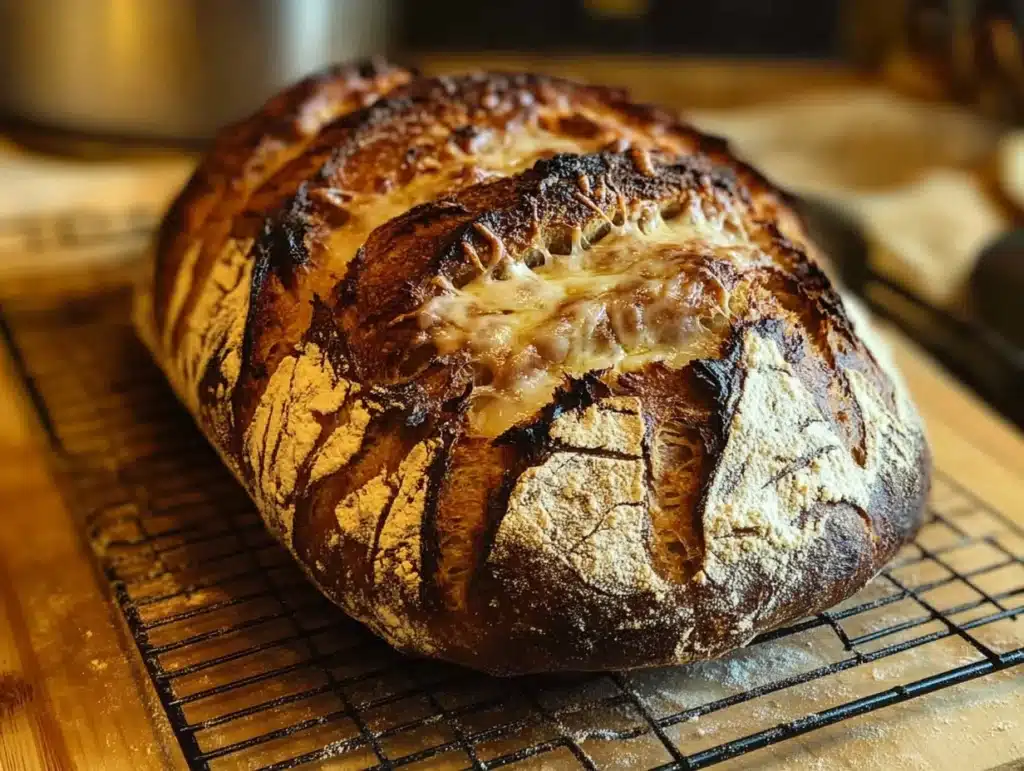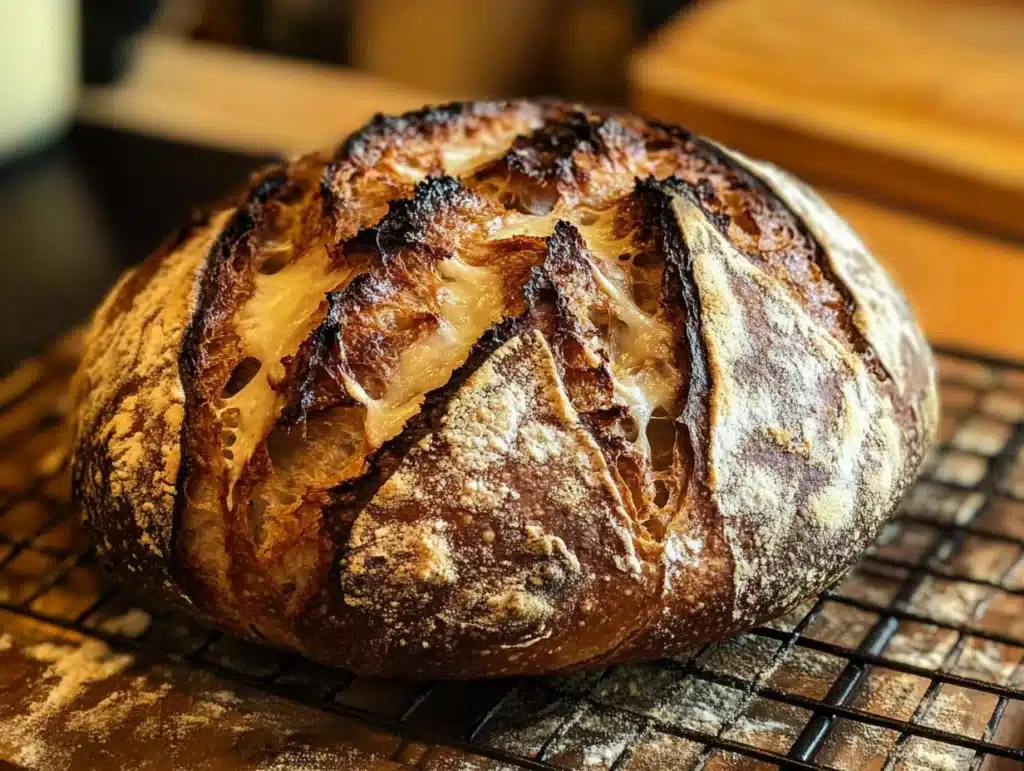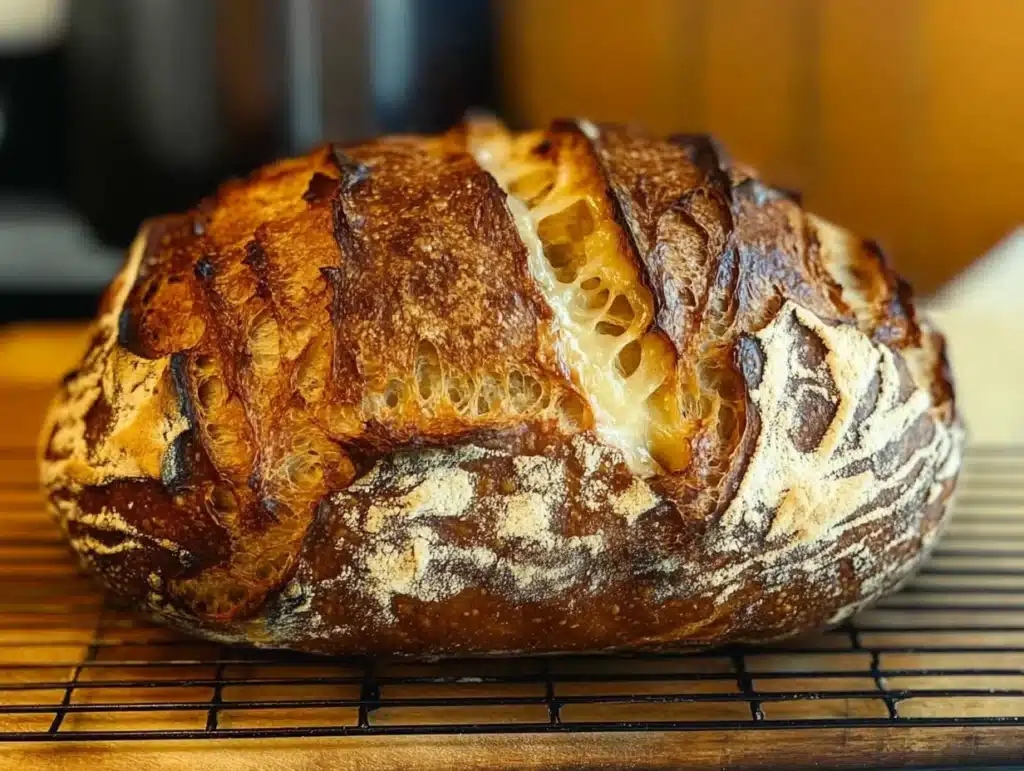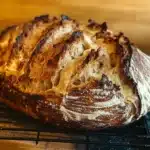There’s something undeniably comforting about the aroma of freshly baked bread wafting through your kitchen. And when it comes to hearty, flavorful, and deeply satisfying loaves, few can compare to a traditional German Rustic Bread Loaf. With its crusty exterior, chewy crumb, and complex earthy flavor, this classic bread is a cornerstone of German cuisine—and now, it’s one you can make at home.
Perfect for breakfast with butter and jam, alongside soup or stew, or as the base for a robust sandwich, this bread is as versatile as it is delicious. Whether you’re an experienced home baker or just starting to explore artisanal loaves, this recipe will guide you step-by-step in creating a rustic masterpiece that celebrates tradition and simplicity.
Let’s explore what makes this bread so special, how to make it from scratch, and all the pro tips for achieving the perfect crust and crumb.
Table of Contents
What Makes a German Rustic Bread Loaf Special?
A German Rustic Bread Loaf—or Bauernbrot—is known for its hearty flavor, dense yet chewy texture, and signature dark crust. Unlike airy white loaves, this bread is rich in whole grains and often made with a blend of rye and wheat flours. It has a slightly tangy taste, thanks to natural fermentation or sourdough starter, and a robust structure that makes it ideal for holding up to toppings, spreads, or warm soups.
Traditionally, this bread is slow-fermented, shaped into a round or oval boule, and baked with steam to achieve a crisp crust. It’s deeply rooted in German food culture and often enjoyed as part of a Brotzeit—Germany’s beloved bread-based meal.
The rustic appearance, natural ingredients, and minimal kneading make it a favorite for home bakers who appreciate honest, wholesome food.
Ingredients for Authentic German Rustic Bread
This recipe stays true to its rustic roots with a simple list of natural ingredients:
500 g wheat flour (type 1050 or all-purpose as substitute)
250 g rye flour (type 997 or whole rye)
500 ml lukewarm water
21 g fresh yeast or 7 g instant dry yeast
2 tsp salt
1 tsp honey or sugar
1 tbsp vinegar (apple cider or white)
Optional: 1 tsp caraway seeds or fennel seeds for flavor
These ingredients work together to produce the signature texture and depth of flavor found in authentic German rustic loaves. The vinegar helps balance the rye’s earthiness, while honey or sugar supports fermentation.
Baking Tools You’ll Need for This Bread Recipe
Before you get started, gather these essential tools for the best baking experience:
Large mixing bowl
Wooden spoon or dough hook (if using a stand mixer)
Damp kitchen towel or plastic wrap
Baking sheet or baking stone
Parchment paper
Bench scraper or knife (for shaping)
Lame or sharp knife (for scoring)
Wire rack for cooling
Optional: Dutch oven or steam tray (to create a crisp crust)
You don’t need fancy gear to make this bread, but a few well-chosen tools will make the process easier and your results more consistent.
How to Make German Rustic Bread Loaf – Step-by-Step
Step 1: Activate the yeast
In a small bowl, mix lukewarm water with yeast and honey or sugar. Stir gently and let it sit for 10 minutes until foamy. If using instant dry yeast, this step is optional but helps ensure activation.
Step 2: Combine dry ingredients
In a large bowl, mix the wheat flour, rye flour, and salt. If you’re using caraway seeds or fennel, stir them in now.
Step 3: Mix the dough
Pour the activated yeast mixture and vinegar into the flour mixture. Stir with a wooden spoon or dough hook until a shaggy dough forms. The dough should be sticky but manageable. Add a bit more flour or water as needed for consistency.
Step 4: Knead and rest
Turn the dough onto a floured surface and knead for about 8–10 minutes, or mix with a stand mixer on low for 5–6 minutes. The dough should be soft, elastic, and slightly tacky.
Step 5: First rise
Place the dough in a lightly oiled bowl. Cover with a damp cloth or plastic wrap and let it rise in a warm spot for 60–90 minutes, until doubled in size.
Step 6: Shape the loaf
Turn the dough out onto a lightly floured surface. Gently deflate it and shape into a round boule or oval loaf. Place it on a parchment-lined baking sheet or proofing basket.
Step 7: Second rise
Cover and let the shaped dough rise for another 30–45 minutes. Meanwhile, preheat your oven to 450°F (230°C). If using a baking stone or Dutch oven, place it inside to heat as well.
Step 8: Score the dough
Just before baking, use a lame or sharp knife to score the top of the dough with a cross or decorative pattern. This helps the bread expand properly in the oven.
Step 9: Bake
Place the loaf in the oven. Add a tray of hot water to the bottom of the oven to create steam or bake inside a Dutch oven for the first 20 minutes with the lid on. Bake for 40–45 minutes total, until the crust is deep golden and the loaf sounds hollow when tapped.
Step 10: Cool and enjoy
Remove the bread and let it cool on a wire rack for at least 1 hour before slicing. This step allows the crumb to set and enhances flavor.
Tips for Perfect Texture, Flavor, and Crust
Use high-quality flours, especially fresh rye flour, for optimal flavor
Let your dough ferment longer in cooler conditions for added complexity
Steam during baking improves the crust’s crispiness and appearance
Resist slicing the bread while it’s hot—this can make the inside gummy
Store in a paper bag or bread box to keep the crust crisp while preserving moisture
The success of your German rustic bread loaf lies in balance—hydration, fermentation, and baking all play essential roles.
How to Shape and Score Rustic German Bread
Shaping gives your bread its structure, and scoring allows it to expand during baking. Here’s how to do it right:
Dust your hands and work surface with flour
Tuck the dough’s edges underneath to create surface tension
Rotate while tightening the shape into a round or oval
Use a lame or very sharp knife to slash the top about ¼ inch deep
Create a single deep cut, an “X,” or rustic diagonal slashes
Scoring also adds visual appeal and tells the story of your loaf’s rise.
Serving Suggestions: What to Pair with German Bread
This bread’s hearty texture and bold flavor make it incredibly versatile. Serve it with:
Soft butter and jam for breakfast
Cold cuts, cheeses, and pickles for a Brotzeit platter
Soups like lentil, potato, or tomato for a warming meal
Smoked salmon and cream cheese for a European-style open sandwich
Honey, mustard, or aioli spreads for dipping
Each slice becomes a canvas for savory or sweet toppings, adding depth to your meal.
Storage Tips: Keeping Your Bread Fresh Longer
Once fully cooled, store your rustic bread loaf like this:
Wrap in a clean kitchen towel or place in a paper bag
Store at room temperature for 3–4 days
Avoid airtight plastic containers—these soften the crust
To refresh the crust, reheat in a 350°F (175°C) oven for 10 minutes
If you want to enjoy the bread throughout the week, freezing is a great option.
Can You Freeze German Rustic Bread Loaf?
Yes, this bread freezes beautifully. Here’s how:
Cool the loaf completely
Slice before freezing for easier portioning
Wrap tightly in plastic wrap, then place in a freezer bag
Freeze for up to 2 months
Reheat individual slices in a toaster or oven for fresh flavor and texture
Freezing your German rustic bread loaf helps you enjoy homemade bread on demand without waste.
Flavor Variations: Seeds, Flours, and Traditional Add-ins
Want to experiment? Try these classic variations:
Add sunflower seeds, pumpkin seeds, or sesame seeds to the dough
Sprinkle oats or rye flakes on top before baking
Replace 100 g of wheat flour with spelt or whole wheat
Mix in chopped walnuts or caramelized onions for extra texture
Use sourdough starter instead of yeast for added complexity
These small changes can transform your loaf while staying true to its rustic roots.
Common Mistakes to Avoid When Making Rustic Bread
Using water that’s too hot—this can kill the yeast
Skipping the second rise—essential for texture and volume
Underbaking the loaf—check internal temp (190–200°F or 88–93°C)
Not preheating the oven—hot air is key for crust formation
Cutting the bread too soon—wait at least an hour after baking
Avoiding these errors ensures your German rustic bread loaf bakes up just right.
FAQ: German Rustic Bread Loaf
Can I make this bread without rye flour?
Yes, but it will lose some of its traditional flavor and density. Try whole wheat as an alternative.
Do I need a Dutch oven?
No, but it helps create steam. You can also add a pan of hot water to the oven for similar results.
Why is my bread dense?
It could be underproofed or over-kneaded. Be sure to give the dough enough rise time and avoid too much flour.
Can I make this recipe into rolls?
Yes. Divide into 8 pieces, shape into rolls, and bake for 20–25 minutes.
What makes this bread “rustic”?
The coarser flours, simple ingredients, crusty exterior, and free-form shaping give it a traditional, rustic look and feel.
Final Thoughts: A Simple Homemade Bread with Deep German Roots
Few things are as rewarding as baking your own bread—and this German Rustic Bread Loaf is a classic that delivers on every level. With its chewy crumb, flavorful crust, and rich aroma, it brings a slice of German tradition into your kitchen.
Whether enjoyed plain, toasted, or stacked with hearty toppings, this bread brings a rustic, old-world charm to every meal. And with this detailed guide, you’re equipped to bake it with confidence.
PrintHomemade German Rustic Bread Loaf : Traditional
- Total Time: 65
Description
There’s something undeniably comforting about the aroma of freshly baked bread wafting through your kitchen.
Ingredients
500 g wheat flour (type 1050 or all-purpose as substitute)
250 g rye flour (type 997 or whole rye)
500 ml lukewarm water
21 g fresh yeast or 7 g instant dry yeast
2 tsp salt
1 tsp honey or sugar
1 tbsp vinegar (apple cider or white)
Optional: 1 tsp caraway seeds or fennel seeds for flavor
Instructions
Step 1: Activate the yeast
In a small bowl, mix lukewarm water with yeast and honey or sugar. Stir gently and let it sit for 10 minutes until foamy. If using instant dry yeast, this step is optional but helps ensure activation.
Step 2: Combine dry ingredients
In a large bowl, mix the wheat flour, rye flour, and salt. If you’re using caraway seeds or fennel, stir them in now.
Step 3: Mix the dough
Pour the activated yeast mixture and vinegar into the flour mixture. Stir with a wooden spoon or dough hook until a shaggy dough forms. The dough should be sticky but manageable. Add a bit more flour or water as needed for consistency.
Step 4: Knead and rest
Turn the dough onto a floured surface and knead for about 8–10 minutes, or mix with a stand mixer on low for 5–6 minutes. The dough should be soft, elastic, and slightly tacky.
Step 5: First rise
Place the dough in a lightly oiled bowl. Cover with a damp cloth or plastic wrap and let it rise in a warm spot for 60–90 minutes, until doubled in size.
Step 6: Shape the loaf
Turn the dough out onto a lightly floured surface. Gently deflate it and shape into a round boule or oval loaf. Place it on a parchment-lined baking sheet or proofing basket.
Step 7: Second rise
Cover and let the shaped dough rise for another 30–45 minutes. Meanwhile, preheat your oven to 450°F (230°C). If using a baking stone or Dutch oven, place it inside to heat as well.
Step 8: Score the dough
Just before baking, use a lame or sharp knife to score the top of the dough with a cross or decorative pattern. This helps the bread expand properly in the oven.
Step 9: Bake
Place the loaf in the oven. Add a tray of hot water to the bottom of the oven to create steam or bake inside a Dutch oven for the first 20 minutes with the lid on. Bake for 40–45 minutes total, until the crust is deep golden and the loaf sounds hollow when tapped.
Step 10: Cool and enjoy
Remove the bread and let it cool on a wire rack for at least 1 hour before slicing. This step allows the crumb to set and enhances flavor.
Notes
Use high-quality flours, especially fresh rye flour, for optimal flavor
Let your dough ferment longer in cooler conditions for added complexity
Steam during baking improves the crust’s crispiness and appearance
- Prep Time: 20
- Cook Time: 45
- Category: Bread
- Cuisine: German
Nutrition
- Serving Size: 10–12 slices
- Calories: 150
- Fat: 5g
- Carbohydrates: 59g
- Fiber: 6g
- Protein: 2g
Keywords: Traditional German Rustic Bread Loaf Recipe







